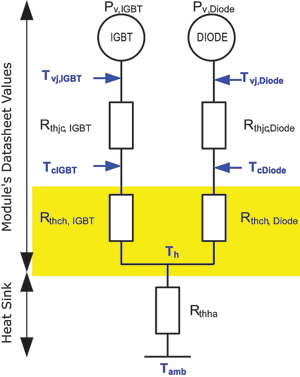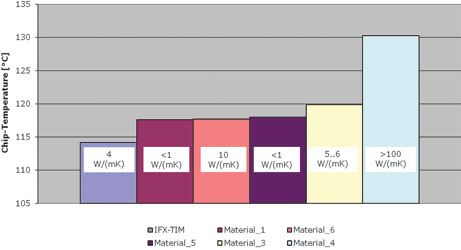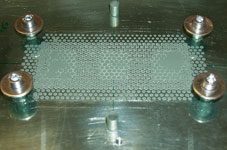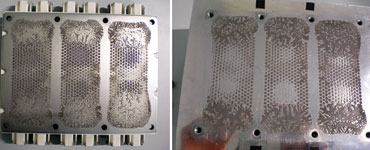
Proper thermal design in power electronics is fundamental to ensuring that the final application will operate over its predicted lifetime. Thus, it remains a key element in the design process. Thermal transfer, including the thermal interface materials (TIM), is the core of power electronic systems. Inadequate handling of these materials or inaccuracies during the design phase can lead to fatal consequences operating the equipment.
Whenever new developments or optimisations of existing designs are ongoing, the developer has to consider what power semiconductor to combine with a certain heatsink. The thermal interface material connecting the semiconductor to the heatsink is usually not reconsidered.
Most often, materials are in use simply because they have been there for years; what was okay for the last decade cannot be wrong today. This, however, is the first misjudgement. Just like semiconductors, thermal interface materials have been enhanced over the years.
Developer searching for alternative materials face an unmanageable variety of possible candidates. This leads to the question of how to evaluate and compare the different materials.
The myth about datasheet values
After extensive research and collecting of data for possible alternatives, the developer takes a well known approach: take the datasheet given by the manufacturer, compare different materials in regards of thermal conductivity and start a simulation to estimate chip temperatures.
A typical scenario usually consists of:
* The maximum ambient temperature expected.
* The known thermal resistances connecting the chip to the module’s base plate – RthJC.
* The heatsink’s thermal resistance to ambient (RthHA) determined through measurement.
* The thermal conductivity of a homogenous layer of grease as described in the datasheet.
* Most likely, the semiconductor’s manufacturer added to the datasheet a typical resistance base plate to heatsink (RthCH) assuming a common grease is in use.
This leads to a simplified thermal model as shown in Figure 1. As long as the losses generated (Pv) are known exactly, the chip temperature results from simple mathematics.

The lack of accuracy of such simplified models becomes obvious if the calculated results are compared to measured data.
As an experiment, a test bench was designed to measure the effectiveness of thermal interface materials. Screen printing was used to apply thermal greases to power modules that were mounted to heatsinks afterwards. The setup consisted of six identical units and provided an insight into chip temperature development throughout an eight-month test period.
It was expected that the thermal interface with the highest conductivity would achieve the lowest chip temperature and, in turn, the longest lifetime. Throughout the eight-month test, daily measurements of the maximum chip temperatures were recorded. As the final result, the average value of these measured temperatures is considered.
Figure 2 summarises the stress test that was conducted for more than 100 000 cycles. The diagram clearly illustrates that there is no correlation at all between the chip temperature achieved in the test and the datasheet value given for thermal conductivity. The material with the highest conductivity leads to the worst result. At the same time, materials that deviate by a factor of 10 in conductivity achieved similar chip temperatures.

Comparing and evaluating the thermal quality of thermal grease purely based on datasheet values is futile.
What is causing this dilemma is the way the datasheet value is determined. The test setup described in the standard ASTM5470-12 features properties that are incompatible to power semiconductors. It is, instead, suitable to describe the situation found in discrete parts or processors.
Surface structures and mounting forces coming from screws are disregarded, just like the fact that a noteworthy portion of heat is transferred by metal-to-metal contact, especially in the area the screws are located in. Further, important parameters, like flow characteristics and wetting abilities of interface materials, are either missing in the description or are very difficult to pinpoint within comparable numbers.
The developer is left with one possibility only: copious in situ tests of the material under consideration in their own particular application.
The glass pane saga
A recurring experiment consists of mounting a module with thermal grease applied to a glass pane to observe the way the material spreads inside the setup.
What appears to be a clever idea at first turns out to be highly questionable, as no knowledge regarding thermal qualities can be derived from this attempt.
A glass pane does not feature the microscopic channels that are common to heatsinks with a milled surface. However, it is this structure that enhances the flow characteristics of paste-like greases. Therefore, the view through a glass pane leads to dubious conclusions.
Instead of mounting a module to a glass pane, the glass can be mounted to a heatsink with thermal grease in between. Though the heatsink now provides the microscopic structure, the glass does not feature the cavities found in power modules. This configuration too does not generate a reliable statement regarding the flow characteristics of thermal greases.

Figure 3 is a photo taken from such a setup. The photo clearly shows that, due to the planar surface, the glass applies homogeneous pressure even in cold conditions. This behaviour is different to what is seen using a power module.
Starting at room temperature, the setup gives a wrong impression that gets even worse if higher temperatures are considered. The base plate of power modules changes in shape at elevated temperature levels due to bimetallic effects. As it lowers towards the heatsink, it applies large mechanical forces to the thermal interface material and in turn to the heatsink.
Heating up the module mounted to the glass pane is not a viable option as the glass can withstand neither the thermal nor the mechanical stress and would be destroyed during the test. Thus, it can be concluded that the experiment is not able to simulate the behaviour of the real application and therefore is of no relevance.
The imprint legend
An equally delusive idea is the art of interpreting imprints. A power electronic system, consisting of module, grease and heatsink, is operated for a certain time and disassembled afterwards. The remaining imprints on module and heatsink are taken as a hint as to the thermal quality of the tested material.
This approach involves guessing the properties of an assembled structure, usually operating at high temperature and under high pressure, by looking at the disassembled components at room temperature. It is self-evident that this approach will not lead to credible statements.
The photograph of the imprint on an EconoPACK + as shown in Figure 4 may be used as an example. The usual interpretation of such an imprint would come up with findings regarding the poor spreading of the grease, obviously caused by too little material being applied, concluding that the thermal transfer clearly was disastrous.

The measurement of the actual chip temperature during the test was done using an infrared camera. In contradiction to the interpretation, the thermal transfer was excellent as no other material in the test achieved similarly low chip temperatures.
Conclusion
Many things regarding thermal interface materials are based on faith rather than measurement. There is only one important parameter – the chip temperature – and the advice can only be to observe this parameter as closely and as accurately as possible.
For more information contact Davis Moodley, Infineon Technologies, +27 (0)11 706 6099, www.infineon.com

© Technews Publishing (Pty) Ltd | All Rights Reserved